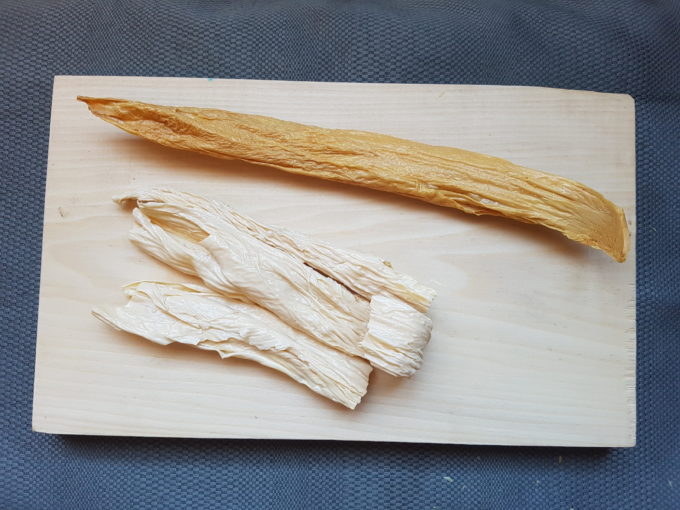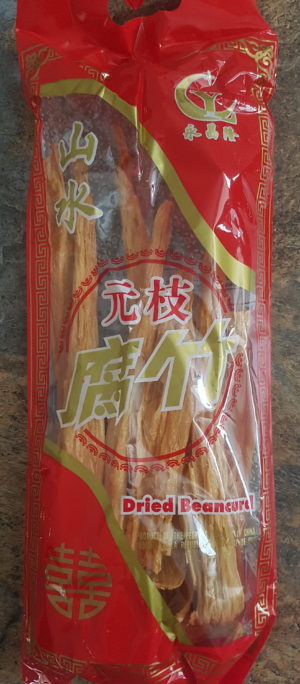Dried Bean Curd

 Dried
Dried  Bean Curd. That just shouts deliciousness, doesn’t it? So delicious might be too strong of a word, and in fact bland wouldn’t be a terrible choice, but awful it is not.
Bean Curd. That just shouts deliciousness, doesn’t it? So delicious might be too strong of a word, and in fact bland wouldn’t be a terrible choice, but awful it is not.
Also known as tofu skin, or yuba in Japanese, dried bean curd is a by product of soy milk production. First the soybeans are soaked for 3-24 hours (depending on the warmth of the season) then ground. At this point the solids are strained out and the high protein milk is retained. (The strained solids are eatable, but are most often used for animal fodder.) If one were to be making tofu, from here they would add a coagulant to the soy milk, strain it, and eventually press and slice this bean curd into those familiar tofu blocks, but for the production of dried bean curd no coagulant is needed. Instead the soy milk is heated in a large shallow pan until the proteins form a skin on the surface, not unlike the skin that forms on gravy or pudding. This is very carefully removed, and hung in sheets or folded. It is said to be the purest form of tofu as there are no added ingredients in getting the solids to form.
Dried bean curds can be found in many shapes, marketed as sticks, sheets, flakes, robes, and even knots. Although you could be lucky enough to get a hold of fresh tofu skin from a local factory, I’m guessing you will probably have to follow the standard directions of soaking dried bean curds. You can use hot or cold water. With very hot water your bean curds will be re-hydrated in about an hour, but if you’re not in a hurry you can simply leave them in a bowl of water for a while. This way they will be ready after 3+ hours. Either option can of-course be adjusted according to your cooking method for the final dish. If you will be boiling or marinading these will affect the curd’s ability to re-hydrate. On the flip side, if you forget about them (even for two days as I have done) they will still be fine.
Like all processed soybean proteins, dried bean curd does not have a huge amount of flavor on it’s own. Instead it does an excellent job of absorbing the umami and seasoning flavors that are presented through your cooking method. Usable in any manner of soup, with noodles, or simply sauced on it’s own or with sauteed vegetables, these re-hydrated bean curds have a pleasantly chewy texture. Some folks even use chopped bean curd sticks to replace chicken in recipes because of this consistency.
With 4 grams of protein per 100g, dried bean curd is not only nutritious and astonishingly easy to use diversely, it is also incredibly cheap. As a side note: it is said that lighter colored sticks and flakes are of higher nutrition.
